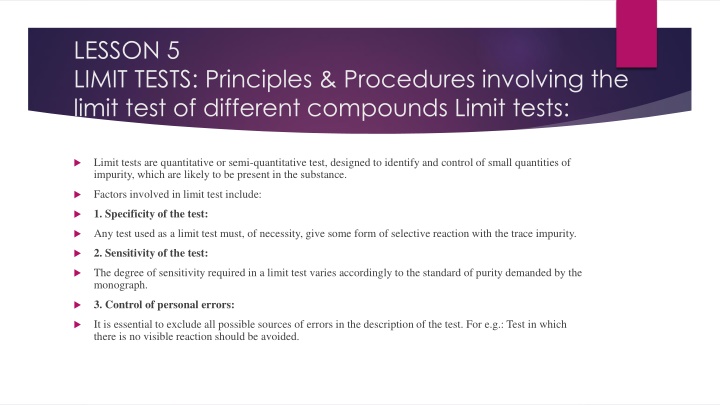
Limit Tests: Principles and Procedures for Control of Impurities
Explore the principles and procedures involved in limit tests for identifying and controlling impurities in substances such as chlorides and sulphates. Learn about the specificities and sensitivities required, along with the importance of personal error control in these tests.
Download Presentation

Please find below an Image/Link to download the presentation.
The content on the website is provided AS IS for your information and personal use only. It may not be sold, licensed, or shared on other websites without obtaining consent from the author. If you encounter any issues during the download, it is possible that the publisher has removed the file from their server.
You are allowed to download the files provided on this website for personal or commercial use, subject to the condition that they are used lawfully. All files are the property of their respective owners.
The content on the website is provided AS IS for your information and personal use only. It may not be sold, licensed, or shared on other websites without obtaining consent from the author.
E N D
Presentation Transcript
LESSON 5 LIMIT TESTS: Principles & Procedures involving the limit test of different compounds Limit tests: Limit tests are quantitative or semi-quantitative test, designed to identify and control of small quantities of impurity, which are likely to be present in the substance. Factors involved in limit test include: 1. Specificity of the test: Any test used as a limit test must, of necessity, give some form of selective reaction with the trace impurity. 2. Sensitivity of the test: The degree of sensitivity required in a limit test varies accordingly to the standard of purity demanded by the monograph. 3. Control of personal errors: It is essential to exclude all possible sources of errors in the description of the test. For e.g.: Test in which there is no visible reaction should be avoided.
Limit test of chlorides PRINCIPLE: Limit test of chlorides is based on the interaction of soluble chloride ion with silver nitrate in presence of nitric acid to obtain silver chloride which is insoluble in nature. Dilute nitric acid is used to prevent the precipitation of other radicals like CO3-,HCO3- ,OH-etc which may be the impurities other than chloride.Thus dil nitric acid only helps to precipitate the silver chloride and also prevents the reversible reaction. AgNO3 is used because all metallic halides are soluble in water except AgX(X=F,Cl,Br,I)
Reaction involved : HNO3 NaCl + AgNO3 AgCl + NaNO3 If opalescence produced in test sample is more as compared to standard then test sample is declared as not of standard quality.
PROCEDURE Test Sample Standard Compound Test Sample Standard Compound 1.Specific weight of compound is dissolved in water or solution is prepared as directed in the pharmacopoeia and transferred in Nessler cylinder 2.Add 1ml of nitric acid 3. Dilute to 50ml in Nessler cylinder 4.Add 1ml of 5% AgNO3 solution 5. Keep aside for 5 min 6. Observe the Opalescence/Turbidity 1.Take 1ml of 0.05845 % W/V solution of sodium chloride in Nessler cylinder 2.Add 1ml of nitric acid 3. Dilute to 50ml in Nessler cylinder 4.Add 1ml 5% of AgNO3 solution 5. Keep aside for 5 min 6. Observe the Opalescence/Turbidity
The turbidity or opalescence in sample and standard solution are now compared by keeping the Nesslers cylinder against proper background and observing side by side. If the turbidity of the sample has been less than that of the standard, then the sample will pass the limit test and vice versa.
LIMIT TEST OF SULPHATE: Principle: It involves interaction of soluble sulphates with barium chloride in presence of HCl HCl SO4 + BaCl2 BaSO4 KCl The turbidity produced by the test solution is compared with standard solution turbidity containing known amount of sulphate . The substance passes the limit test if sample produces turbidity less than that of standard .
NOTE:In IP , BaCl2reagent has been replaced by BaSO4reagent which contains BaCl2,sulphate free alcohol and solution of K2SO4. BaSO4 reagent includes BaCl2, Sulphate free alcohol, potassium sulphate BaCl2 very sparingly soluble, on addition of it to the solution containing sulphate or barium will immediately cause precipitation. Alcohol helps to prevent super saturation and produces more uniform opalescence K2SO4 used to increase the sensitivity of test HCl- It prevents turbidity due to BaCO3 or any carbonate.
PROCEDURE: SNo 1 TEST STANDARD 2g of NaCl was dissolved in 10ml of distilled water and transferred to Nessler s cylinder A 1ml of 0.1089%w/v potassium sulphate and 9ml of distilled water was taken in Nessler s cylinder B 2 To this ,2ml of dil HCl was added To this ,2ml of dil HCl was added 3 Diluted with water to 45 ml Diluted with water to 45 ml 5ml of BaSO4 reagent was added and stirred immediately and kept aside for 5min 5ml of BaSO4 reagent was added and stirred immediately and kept aside for 5min 4
If the turbidity produced by the test solution has been less than the standard turbidity, the sample would pass the limit test for sulphate.






















